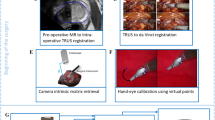Abstract
Purpose
Intra-operative augmented reality (AR) during surgery can mitigate incomplete cancer removal by overlaying the anatomical boundaries extracted from medical imaging data onto the camera image. In this paper, we present the first such completely markerless AR guidance system for robot-assisted laparoscopic radical prostatectomy (RALRP) that transforms medical data from transrectal ultrasound (TRUS) to endoscope camera image. Moreover, we reduce the total number of transformations by combining the hand–eye and camera calibrations in a single step.
Methods
Our proposed solution requires two transformations: TRUS to robot, \(^\mathrm{DV}T_\mathrm{TRUS}\), and camera projection matrix, \(\mathbf{M} \) (i.e., the transformation from endoscope to camera image frame). \(^\mathrm{DV}T_\mathrm{TRUS}\) is estimated by the method proposed in Mohareri et al. (in J Urol 193(1):302–312, 2015). \(\mathbf{M} \) is estimated by selecting corresponding 3D-2D data points in the endoscope and the image coordinate frame, respectively, by using a CAD model of the surgical instrument and a preoperative camera intrinsic matrix with an assumption of a projective camera. The parameters are estimated using Levenberg–Marquardt algorithm. Overall mean re-projection errors (MRE) are reported using simulated and real data using a water bath. We show that \(\mathbf{M} \) can be re-estimated if the focus is changed during surgery.
Results
Using simulated data, we received an overall MRE in the range of 11.69–13.32 pixels for monoscopic and stereo left and right cameras. For the water bath experiment, the overall MRE is in the range of 26.04–30.59 pixels for monoscopic and stereo cameras. The overall system error from TRUS to camera world frame is 4.05 mm. Details of the procedure are given in supplementary material.
Conclusion
We demonstrate a markerless AR guidance system for RALRP that does not need calibration markers and thus has the capability to re-estimate the camera projection matrix if it changes during surgery, e.g., due to a focus change.





Similar content being viewed by others
References
Adebar TK, Yip MC, Salcudean SE, Rohling RN, Nguan CY, Goldenberg SL (2012) Registration of 3d ultrasound through an air-tissue boundary. IEEE Trans Med Imaging 31(11):2133–2142
Davis JW, Kreaden US, Gabbert J, Thomas R (2014) Learning curve assessment of robot-assisted radical prostatectomy compared with open-surgery controls from the premier perspective database. J Endourol 28(5):560–566
Geiger A, Moosmann F, Car Ö, Schuster B (2012) Automatic camera and range sensor calibration using a single shot. In: 2012 IEEE international conference on robotics and automation, pp 3936–3943. IEEE
Hartley R, Zisserman A (2003) Multiple view geometry in computer vision. Cambridge University Press, Cambridge
Hartley RI (1997) In defense of the eight-point algorithm. IEEE Trans Pattern Anal Mach Intell 19(6):580–593
Kalia M, Mathur P, Tsang K, Black P, Navab N, Salcudean S (2020) Evaluation of a marker-less, intra-operative, augmented reality guidance system for robot-assisted laparoscopic radical prostatectomy. Int J Comput Assist Radiol Surg 15:1225–1233
Kolagunda A, Sorensen S, Mehralivand S, Saponaro P, Treible W, Turkbey B, Pinto P, Choyke P, Kambhamettu C (2018) A mixed reality guidance system for robot assisted laparoscopic radical prostatectomy. In: OR 2.0 context-aware operating theaters, computer assisted robotic endoscopy, clinical image-based procedures, and skin image analysis, pp 164–174. Springer
Linte CA, Davenport KP, Cleary K, Peters C, Vosburgh KG, Navab N, Jannin P, Peters TM, Holmes DR III, Robb RA (2013) On mixed reality environments for minimally invasive therapy guidance: systems architecture, successes and challenges in their implementation from laboratory to clinic. Comput Med Imaging Graph 37(2):83–97
Mitterberger M, Horninger W, Aigner F, Pinggera GM, Steppan I, Rehder P, Frauscher F (2010) Ultrasound of the prostate. Cancer Imaging 10(1):40
Mohareri O, Ischia J, Black PC, Schneider C, Lobo J, Goldenberg L, Salcudean SE (2015) Intraoperative registered transrectal ultrasound guidance for robot-assisted laparoscopic radical prostatectomy. J Urol 193(1):302–312
Porpiglia F, Fiori C, Checcucci E, Amparore D, Bertolo R (2018) Augmented reality robot-assisted radical prostatectomy: preliminary experience. Urology 115:184
Samei G, Tsang K, Kesch C, Lobo J, Hor S, Mohareri O, Chang S, Goldenberg SL, Black PC, Salcudean S (2019) A partial augmented reality system with live ultrasound and registered preoperative MRI for guiding robot-assisted radical prostatectomy. Med Image Anal. https://doi.org/10.1016/j.media.2019.101588
Silberstein JL, Eastham JA (2014) Significance and management of positive surgical margins at the time of radical prostatectomy. Indian J Urol: IJU: J Urol Soc India 30(4):423
Thompson S, Penney G, Billia M, Challacombe B, Hawkes D, Dasgupta P (2013) Design and evaluation of an image-guidance system for robot-assisted radical prostatectomy. BJU Int 111(7):1081–1090
Ye M, Zhang L, Giannarou S, Yang GZ (2016) Real-time 3d tracking of articulated tools for robotic surgery. In: International conference on medical image computing and computer-assisted intervention, pp 386–394. Springer
Zhang Z (2000) A flexible new technique for camera calibration. IEEE Trans Pattern Anal Mach Intell 22(11):1330–1334
Acknowledgements
We are thankful for financial support provided by the Canadian Institutes of Health Research (CIHR), the Natural Sciences and Engineering Research Council (NSERC) and the Charles Laszlo Chair in Biomedical Engineering held by Professor Salcudean. Canada Foundation of Innovation (CFI) provided infrastructure support. We would also like to thank Intuitive Surgical for providing the da Vinci Research API and support.
Author information
Authors and Affiliations
Corresponding author
Ethics declarations
Conflicts of interest
The authors have no conflicts of interest.
Ethical approval
This article does not contain any studies with human participants or animals performed by any of the authors.
Informed consent
This article does not contain patient data.
Additional information
Publisher's Note
Springer Nature remains neutral with regard to jurisdictional claims in published maps and institutional affiliations.
Supplementary Information
Below is the link to the electronic supplementary material.
Rights and permissions
About this article
Cite this article
Kalia, M., Avinash, A., Navab, N. et al. Preclinical evaluation of a markerless, real-time, augmented reality guidance system for robot-assisted radical prostatectomy. Int J CARS 16, 1181–1188 (2021). https://doi.org/10.1007/s11548-021-02419-9
Received:
Accepted:
Published:
Issue Date:
DOI: https://doi.org/10.1007/s11548-021-02419-9




